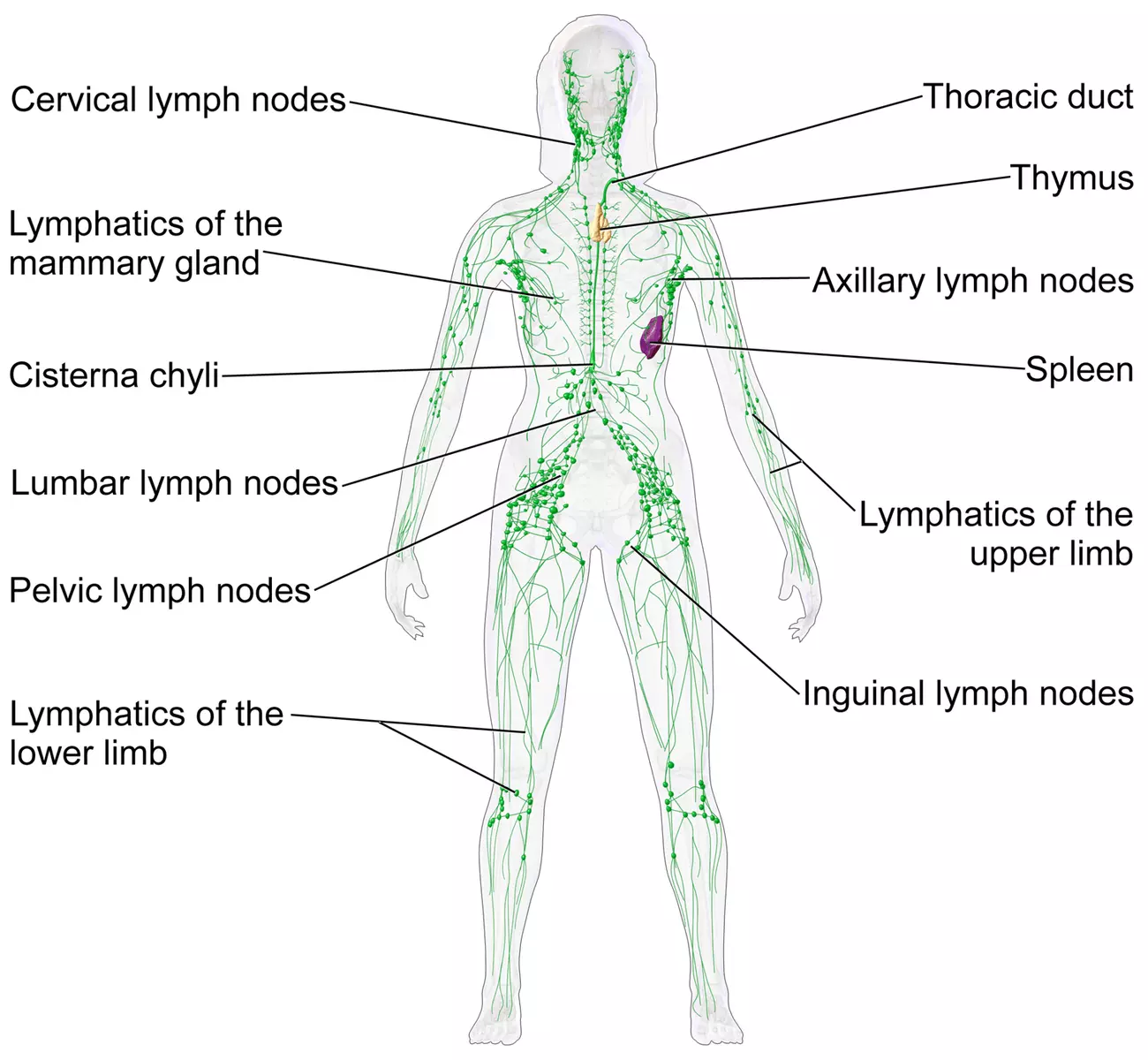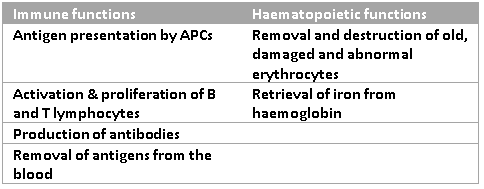By Emily Smith
Next Lesson - Haemostasis and Clotting
Abstract
- The lymphatic system filters excess fluid and acts like a security system against pathogens. The excess fluid is then returned to systemic circulation in the veins. The lymphatic system consists of:
- Lymph fluid - surrounding cells in body tissues, and carried in the lymph vessels.
- Vessels - carry the lymph from the tissues, through lymph nodes, to eventually drain into the blood.
- Cells - include T and B lymphocytes, follicular dendritic cells and macrophages.
- Organs - including lymph nodes, the spleen and thymus.
Core
Diagram - Layout of the lymphatic and ducts system within the body
Creative commons source by BruceBlaus and CFCF [CC BY-SA 4.0 (https://creativecommons.org/licenses/by-sa/4.0)]
This is essentially made up of excess interstitial fluid – fluid that’s been pushed out the capillaries and is found in the spaces between cells. Lymphatic fluid is formed by the filtration of this interstitial fluid into the lymphatic vessels.
There is high hydrostatic pressure in the arteriole end of the capillary. This forces fluid out into the interstitium. This increases the oncotic pressure (pressure due to proteins) at the venule end, which pulls back most of the fluid. About 20 litres of fluid is filtered out per day. However, only 17 litres are drawn back into the capillaries. The remaining 3 litres makes up the lymph.
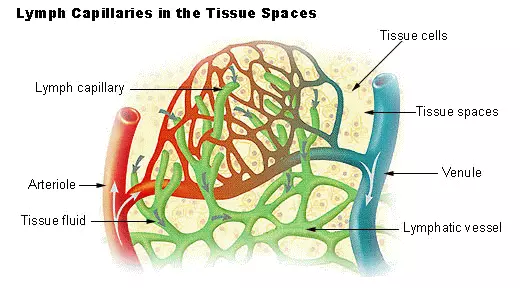
Diagram - Shows the movement of fluid in the blood from the capillaries into the tissue spaces (interstitium) where it becomes tissue fluid (interstitial fluid). The newly formed tissue fluid can then move into the lymphatic vessels where it becomes lymphatic fluid.
Creative commons source by SEER [CC BY-SA 4.0 (https://creativecommons.org/licenses/by-sa/4.0)]
Lymphatic vessels carry lymph fluid and lie adjacent to arteries and veins. Flow within the vessels goes from superficial to deep.
They are made up of loosely overlapping endothelial cells. The overlapping cells form valves, so when pressure is higher in the interstitium, the valves open and fluid can enter the vessel where it is now called the lymph.
Deep lymphatics in the limbs pass through muscles. Contraction of these muscles helps with lymph circulation. Larger lymphatics in the abdomen and thorax have smooth muscle in their walls which contracts to help flow here.
The lymph is drained into ducts which feed into the lowest pressure parts of the circulatory system.
- Right lymphatic duct drains the lymph from the right side of the thorax, head and neck, and the right arm. The lymph received drains into the right subclavian vein.
- The thoracic duct drains the rest of the body into the left subclavian vein.
These are the main lymphoid organs. They act as filters for lymph as it travels back to the venous system.
Lymph nodes are present at various points along lymphatic vessels and are often grouped together. Some of these groups are:
- Cervical (neck)
- Axillary (armpit)
- Inguinal (groin)
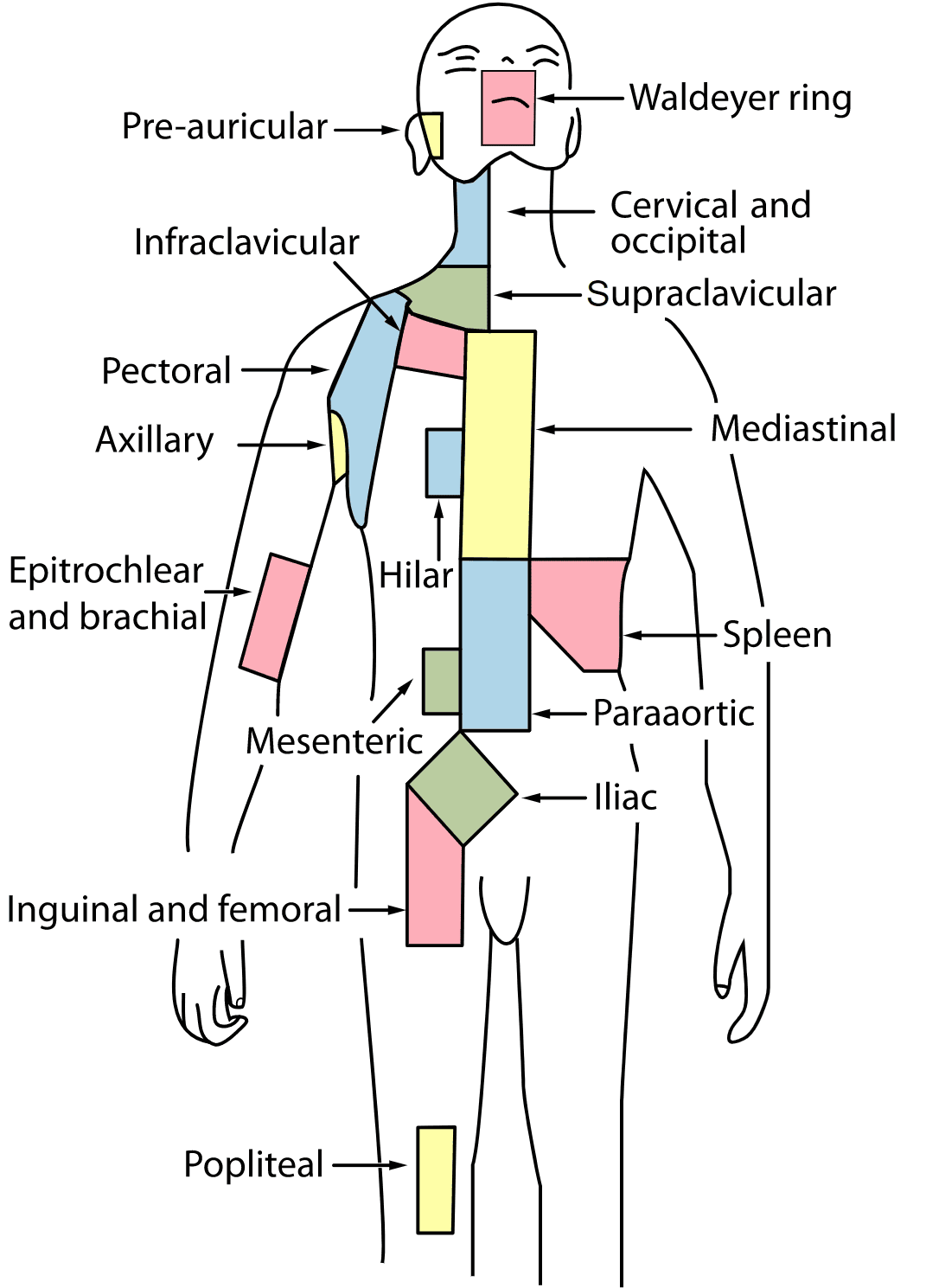
Diagram - Regions that lymph nodes are found in
Creative commons source by Fred the Oyster [CC BY-SA 4.0 (https://creativecommons.org/licenses/by-sa/4.0)]
Lymph fluid enters the lymph node through the afferent vessels on the convex surface, and leaves through the efferent vessel at the hilum. Each node also has a feeding artery and draining vein that enter and leave through the hilum.
Lymph nodes are involved in the immune response, so contain immune cells.
- Follicular dendritic cells are in the germinal centre. They cause proliferation of B lymphocytes.
- Macrophages engulf and digest pathogens, this is phagocytosis. They also act as antigen-presenting cells (APCs) to activate other immune cells.
- B lymphocytes secrete antibodies.
- T lymphocytes directly attack any pathogens and are involved in managing the immune response. They require activation from APCs.
When an antigen is first detected, the reaction is the innate response. This is mediated by neutrophils and macrophages. Presentation of the antigen leads to an adaptive immune response.
The specific immune response is a mix of humoral (B lymphocyte mediated) and cell-mediated (T cell mediated).
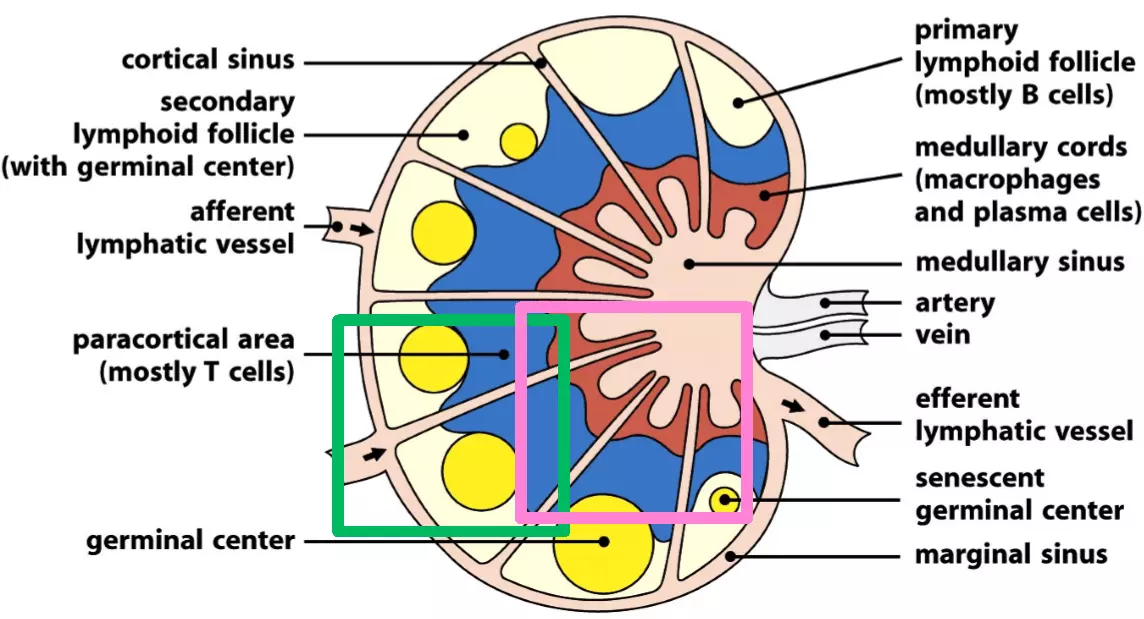
Diagram - A lymph node, showing the filtration system components and different areas of a lymph node
Creative commons source by Garland Science 2008 [CC BY-SA 4.0 (https://creativecommons.org/licenses/by-sa/4.0)]
The spleen is an intraperitoneal organ in the upper left quadrant of the abdomen. It has immune and haematopoietic functions and filters blood similar to how the lymph nodes filter lymph. It has a particular role in destroying encapsulated bacteria such as Neisseria meningitidis, which is why it’s important for people without a spleen to have vaccinations against these bacteria.
Table - Functions of the spleen
SimpleMed original by Emily Smith
This is in the superior mediastinum. Its role is the maturation of bone marrow derived stem cells into mature T cells during the early years of life. After puberty, it decreases in size and is replaced by fat.
An element of the maturation of T cells is thymic tolerance (also called central tolerance). This is the destruction of T cells that recognise the antigens on body tissues as non-self. This process is designed to stop the development of an autoimmune response against the body’s own tissues.
Other Lymphatic Tissue
There is also some lymphatic tissue in the tonsils, walls of the gastrointestinal tract and appendix.
- Tonsils form a ring around the entrance of the pharynx (Waldeyer Ring). They check anything entering the GI tract for pathogens.
- Peyer’s patches are in the distal part of the small intestine. They act as another checkpoint for any pathogens along the GI tract.
- The appendix sits by the caecum and also contains lymphatic tissue, to further check for any pathogens before they could breach the intestinal wall during absorption.
This is when there is a collection of lymph fluid due to impaired lymphatic drainage. It commonly affects the limbs, and presents with:
- Swelling that is non-pitting (won’t form a dent in the skin when pressed)
- Tight skin
- Repeated skin infections
- Aching feeling
Without treatment, it can become more severe and persistent.
- Primary lymphoedema – the genetic form which can develop at any age. It usually starts in infancy, adolescence or early adulthood.
- Secondary lymphoedema – due to damage to the lymphatic system. It can be a result of cancer treatment (e.g. removal of axillary lymph nodes for breast cancer treatment), infection or injury to limb.
This is swelling of the lymph nodes. It is most commonly caused by infections. Although sometimes it can be caused by cancers like lymphoma or leukaemia, or a metastasis from another organ. Typically cancerous lymph nodes are hard or rubbery and are non-tender.
This is enlargement of the spleen in response to infection. It is usually due to a local infection. But it could be due to a systemic infection such as glandular fever or malaria.
Edited by: Bethany Turner
- 14281

